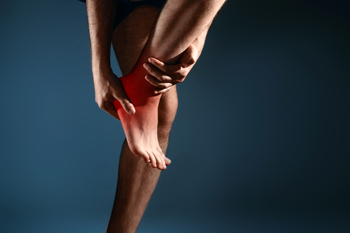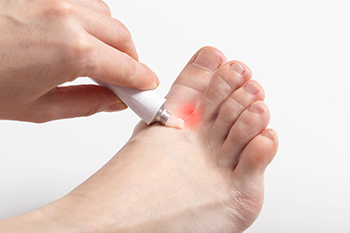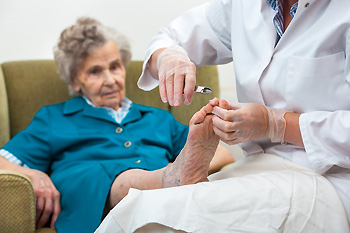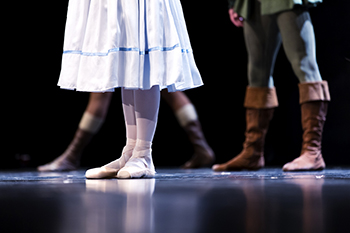Items filtered by date: June 2022
Say Goodnight to Nocturnal Muscle Cramps in Your Feet

It’s hard enough getting a good night’s sleep without muscle cramps in your feet keeping you awake. The nocturnal foot cramps you may be experiencing are actually contractions in the muscles or muscle fibers in your feet. Foot cramps occurring at night may be caused by muscle fatigue due to overtaxing the feet muscles, low levels of potassium (hypokalemia) or magnesium, medication side effects, pregnancy, or shoes that are too tight or that fail to provide adequate arch support. There are certain medical issues that may lead to nocturnal foot cramps, including arthritis, high blood pressure, diabetes, depression, thyroid disease, asthma, and heart attacks. Other contributing factors to developing these troublesome cramps are pregnancy, smoking, obesity, old age, and poor health. Consult with a podiatrist if your nocturnal muscle cramps do not improve within a couple of weeks to receive an accurate diagnosis and to discuss your treatment options.
Foot Pain
Foot pain can be extremely painful and debilitating. If you have a foot pain, consult with Jack A. Sasiene, DPM from Texas. Our doctor will assess your condition and provide you with quality foot and ankle treatment.
Causes
Foot pain is a very broad condition that could be caused by one or more ailments. The most common include:
- Bunions
- Hammertoes
- Plantar Fasciitis
- Bone Spurs
- Corns
- Tarsal Tunnel Syndrome
- Ingrown Toenails
- Arthritis (such as Gout, Rheumatoid, and Osteoarthritis)
- Flat Feet
- Injury (from stress fractures, broken toe, foot, ankle, Achilles tendon ruptures, and sprains)
- And more
Diagnosis
To figure out the cause of foot pain, podiatrists utilize several different methods. This can range from simple visual inspections and sensation tests to X-rays and MRI scans. Prior medical history, family medical history, and any recent physical traumatic events will all be taken into consideration for a proper diagnosis.
Treatment
Treatment depends upon the cause of the foot pain. Whether it is resting, staying off the foot, or having surgery; podiatrists have a number of treatment options available for foot pain.
If you have any questions, please feel free to contact our offices located in Texas City and Lake Jackson, TX . We offer the newest diagnostic and treatment technologies for all your foot care needs.
Different Types of Athlete’s Foot

People who have had athlete's foot are aware of the discomfort it can cause. The skin often becomes dry, red, and can itch too. It is considered to be a fungal infection and typically affects the soles of the feet and between the toes. It is a contagious infection and appropriate shoes are suggested to be worn while in public swimming areas, locker rooms, and shower room floors. This fungus lives in warm and moist environments including socks and shoes that are wet. There are three types of athlete's foot. A toe web infection can cause the skin to peel and crack between the third and fourth toes. Cracked skin on the heel can be referred to as a moccasin-type infection, and a blister on the sole of the foot is known as a vesicular type of infection. There are effective prevention techniques for athlete’s foot including keeping the feet clean and dry, refraining from sharing towels or shoes, and alternating the shoes worn daily. If you have been affected by athlete's foot, please consult with a podiatrist who can determine what the best type of treatment is for you.
Athlete’s Foot
Athlete’s foot is often an uncomfortable condition to experience. Thankfully, podiatrists specialize in treating athlete’s foot and offer the best treatment options. If you have any questions about athlete’s foot, consult with Jack A. Sasiene, DPM from Texas. Our doctor will assess your condition and provide you with quality treatment.
What Is Athlete’s Foot?
Tinea pedis, more commonly known as athlete’s foot, is a non-serious and common fungal infection of the foot. Athlete’s foot is contagious and can be contracted by touching someone who has it or infected surfaces. The most common places contaminated by it are public showers, locker rooms, and swimming pools. Once contracted, it grows on feet that are left inside moist, dark, and warm shoes and socks.
Prevention
The most effective ways to prevent athlete’s foot include:
- Thoroughly washing and drying feet
- Avoid going barefoot in locker rooms and public showers
- Using shower shoes in public showers
- Wearing socks that allow the feet to breathe
- Changing socks and shoes frequently if you sweat a lot
Symptoms
Athlete’s foot initially occurs as a rash between the toes. However, if left undiagnosed, it can spread to the sides and bottom of the feet, toenails, and if touched by hand, the hands themselves. Symptoms include:
- Redness
- Burning
- Itching
- Scaly and peeling skin
Diagnosis and Treatment
Diagnosis is quick and easy. Skin samples will be taken and either viewed under a microscope or sent to a lab for testing. Sometimes, a podiatrist can diagnose it based on simply looking at it. Once confirmed, treatment options include oral and topical antifungal medications.
If you have any questions, please feel free to contact our offices located in Texas City and Lake Jackson, TX . We offer the newest diagnostic and treatment technologies for all your foot care needs.
Different Types of Athlete’s Foot

People who have had athlete's foot are aware of the discomfort it can cause. The skin often becomes dry, red, and can itch too. It is considered to be a fungal infection and typically affects the soles of the feet and between the toes. It is a contagious infection and appropriate shoes are suggested to be worn while in public swimming areas, locker rooms, and shower room floors. This fungus lives in warm and moist environments including socks and shoes that are wet. There are three types of athlete's foot. A toe web infection can cause the skin to peel and crack between the third and fourth toes. Cracked skin on the heel can be referred to as a moccasin-type infection, and a blister on the sole of the foot is known as a vesicular type of infection. There are effective prevention techniques for athlete’s foot including keeping the feet clean and dry, refraining from sharing towels or shoes, and alternating the shoes worn daily. If you have been affected by athlete's foot, please consult with a podiatrist who can determine what the best type of treatment is for you.
Athlete’s Foot
Athlete’s foot is often an uncomfortable condition to experience. Thankfully, podiatrists specialize in treating athlete’s foot and offer the best treatment options. If you have any questions about athlete’s foot, consult with Jack A. Sasiene, DPM from Texas. Our doctor will assess your condition and provide you with quality treatment.
What Is Athlete’s Foot?
Tinea pedis, more commonly known as athlete’s foot, is a non-serious and common fungal infection of the foot. Athlete’s foot is contagious and can be contracted by touching someone who has it or infected surfaces. The most common places contaminated by it are public showers, locker rooms, and swimming pools. Once contracted, it grows on feet that are left inside moist, dark, and warm shoes and socks.
Prevention
The most effective ways to prevent athlete’s foot include:
- Thoroughly washing and drying feet
- Avoid going barefoot in locker rooms and public showers
- Using shower shoes in public showers
- Wearing socks that allow the feet to breathe
- Changing socks and shoes frequently if you sweat a lot
Symptoms
Athlete’s foot initially occurs as a rash between the toes. However, if left undiagnosed, it can spread to the sides and bottom of the feet, toenails, and if touched by hand, the hands themselves. Symptoms include:
- Redness
- Burning
- Itching
- Scaly and peeling skin
Diagnosis and Treatment
Diagnosis is quick and easy. Skin samples will be taken and either viewed under a microscope or sent to a lab for testing. Sometimes, a podiatrist can diagnose it based on simply looking at it. Once confirmed, treatment options include oral and topical antifungal medications.
If you have any questions, please feel free to contact our offices located in Texas City and Lake Jackson, TX . We offer the newest diagnostic and treatment technologies for all your foot care needs.
Foot Cramps in the Elderly

Foot cramps are a result of the foot muscles involuntarily contracting. They are inconvenient, uncomfortable, and even painful, but they are usually not serious. One may experience a foot cramp due to dehydration, muscle fatigue, or exercising without proper stretching of the calves and feet. They may also result from a side effect of a medication or a nutritional deficiency. With age, nerves and muscles may wear out and cramping can occur. Older people are also generally less active than younger people, therefore, they may have a higher risk for these muscle spasms. Furthermore, nocturnal foot cramps may be related to a circulation disorder, which is also more common among the elderly. Wearing well-fitting, supportive shoes can help as well as massaging the feet and using cool or warm compresses when a foot cramp occurs. If you suffer from severe or frequent muscle cramps in your feet, it is suggested you consult with a podiatrist who can help diagnose the cause and provide the proper treatment regime.
Proper foot care is something many older adults forget to consider. If you have any concerns about your feet and ankles, contact Jack A. Sasiene, DPM from Texas. Our doctor can provide the care you need to keep you pain-free and on your feet.
The Elderly and Their Feet
As we age we start to notice many changes in our body, but the elder population may not notice them right away. Medical conditions may prevent the elderly to take notice of their foot health right away. Poor vision is a lead contributor to not taking action for the elderly.
Common Conditions
- Neuropathy – can reduce feeling in the feet and can hide many life-threatening medical conditions.
- Reduced flexibility – prevents the ability of proper toenail trimming, and foot cleaning. If left untreated, it may lead to further medical issues.
- Foot sores – amongst the older population can be serious before they are discovered. Some of the problematic conditions they may face are:
- Gouging toenails affecting nearby toe
- Shoes that don’t fit properly
- Pressure sores
- Loss of circulation in legs & feet
- Edema & swelling of feet and ankles
Susceptible Infections
Diabetes and poor circulation can cause general loss of sensitivity over the years, turning a simple cut into a serious issue.
If you have any questions please feel free to contact our offices located in Texas City and Lake Jackson, TX . We offer the newest diagnostic and treatment technologies for all your foot and ankle needs.
Foot Cramps in the Elderly

Foot cramps are a result of the foot muscles involuntarily contracting. They are inconvenient, uncomfortable, and even painful, but they are usually not serious. One may experience a foot cramp due to dehydration, muscle fatigue, or exercising without proper stretching of the calves and feet. They may also result from a side effect of a medication or a nutritional deficiency. With age, nerves and muscles may wear out and cramping can occur. Older people are also generally less active than younger people, therefore, they may have a higher risk for these muscle spasms. Furthermore, nocturnal foot cramps may be related to a circulation disorder, which is also more common among the elderly. Wearing well-fitting, supportive shoes can help as well as massaging the feet and using cool or warm compresses when a foot cramp occurs. If you suffer from severe or frequent muscle cramps in your feet, it is suggested you consult with a podiatrist who can help diagnose the cause and provide the proper treatment regime.
Proper foot care is something many older adults forget to consider. If you have any concerns about your feet and ankles, contact Jack A. Sasiene, DPM from Texas. Our doctor can provide the care you need to keep you pain-free and on your feet.
The Elderly and Their Feet
As we age we start to notice many changes in our body, but the elder population may not notice them right away. Medical conditions may prevent the elderly to take notice of their foot health right away. Poor vision is a lead contributor to not taking action for the elderly.
Common Conditions
- Neuropathy – can reduce feeling in the feet and can hide many life-threatening medical conditions.
- Reduced flexibility – prevents the ability of proper toenail trimming, and foot cleaning. If left untreated, it may lead to further medical issues.
- Foot sores – amongst the older population can be serious before they are discovered. Some of the problematic conditions they may face are:
- Gouging toenails affecting nearby toe
- Shoes that don’t fit properly
- Pressure sores
- Loss of circulation in legs & feet
- Edema & swelling of feet and ankles
Susceptible Infections
Diabetes and poor circulation can cause general loss of sensitivity over the years, turning a simple cut into a serious issue.
If you have any questions please feel free to contact our offices located in Texas City and Lake Jackson, TX . We offer the newest diagnostic and treatment technologies for all your foot and ankle needs.
Sports Injuries in Dancers

There are a variety of factors that can contribute to a dancer injuring their feet or ankles. Some factors are things the dancer cannot control, such as body type, age, the shape of feet and ankles, existing medical conditions or prior injuries, and the type of dance and surface they are dancing on. Other factors that can be avoided and are within the dancer’s control include not warming up/stretching/cooling down properly, wearing improper footwear, not staying hydrated or eating properly, and not building up the frequency or duration of performances and/or practices gradually. Dancing injuries can also occur if the dancer is attempting moves that are beyond their skill or ability at the time of injury. Any type of foot or ankle injury that a dancer suffers should be examined by a podiatrist as soon as possible. Trying to “muscle through” an injury that needs professional treatment can lead to further injury and may even prevent the dancer from being able to dance if the injury does not heal properly. Every dancer is different, and every injury is different. A podiatrist will create a custom treatment plan after thoroughly examining the dancer’s injury.
Sports related foot and ankle injuries require proper treatment before players can go back to their regular routines. For more information, contact Jack A. Sasiene, DPM of Texas. Our doctor can provide the care you need to keep you pain-free and on your feet.
Sports Related Foot and Ankle Injuries
Foot and ankle injuries are a common occurrence when it comes to athletes of any sport. While many athletes dismiss the initial aches and pains, the truth is that ignoring potential foot and ankle injuries can lead to serious problems. As athletes continue to place pressure and strain the area further, a mild injury can turn into something as serious as a rupture and may lead to a permanent disability. There are many factors that contribute to sports related foot and ankle injuries, which include failure to warm up properly, not providing support or wearing bad footwear. Common injuries and conditions athletes face, including:
- Plantar Fasciitis
- Plantar Fasciosis
- Achilles Tendinitis
- Achilles Tendon Rupture
- Ankle Sprains
Sports related injuries are commonly treated using the RICE method. This includes rest, applying ice to the injured area, compression and elevating the ankle. More serious sprains and injuries may require surgery, which could include arthroscopic and reconstructive surgery. Rehabilitation and therapy may also be required in order to get any recovering athlete to become fully functional again. Any unusual aches and pains an athlete sustains must be evaluated by a licensed, reputable medical professional.
If you have any questions please feel free to contact our offices located in Texas City and Lake Jackson, TX . We offer the newest diagnostic and treatment technologies for all your foot and ankle needs.
Sports Injuries in Dancers

There are a variety of factors that can contribute to a dancer injuring their feet or ankles. Some factors are things the dancer cannot control, such as body type, age, the shape of feet and ankles, existing medical conditions or prior injuries, and the type of dance and surface they are dancing on. Other factors that can be avoided and are within the dancer’s control include not warming up/stretching/cooling down properly, wearing improper footwear, not staying hydrated or eating properly, and not building up the frequency or duration of performances and/or practices gradually. Dancing injuries can also occur if the dancer is attempting moves that are beyond their skill or ability at the time of injury. Any type of foot or ankle injury that a dancer suffers should be examined by a podiatrist as soon as possible. Trying to “muscle through” an injury that needs professional treatment can lead to further injury and may even prevent the dancer from being able to dance if the injury does not heal properly. Every dancer is different, and every injury is different. A podiatrist will create a custom treatment plan after thoroughly examining the dancer’s injury.
Sports related foot and ankle injuries require proper treatment before players can go back to their regular routines. For more information, contact Jack A. Sasiene, DPM of Texas. Our doctor can provide the care you need to keep you pain-free and on your feet.
Sports Related Foot and Ankle Injuries
Foot and ankle injuries are a common occurrence when it comes to athletes of any sport. While many athletes dismiss the initial aches and pains, the truth is that ignoring potential foot and ankle injuries can lead to serious problems. As athletes continue to place pressure and strain the area further, a mild injury can turn into something as serious as a rupture and may lead to a permanent disability. There are many factors that contribute to sports related foot and ankle injuries, which include failure to warm up properly, not providing support or wearing bad footwear. Common injuries and conditions athletes face, including:
- Plantar Fasciitis
- Plantar Fasciosis
- Achilles Tendinitis
- Achilles Tendon Rupture
- Ankle Sprains
Sports related injuries are commonly treated using the RICE method. This includes rest, applying ice to the injured area, compression and elevating the ankle. More serious sprains and injuries may require surgery, which could include arthroscopic and reconstructive surgery. Rehabilitation and therapy may also be required in order to get any recovering athlete to become fully functional again. Any unusual aches and pains an athlete sustains must be evaluated by a licensed, reputable medical professional.
If you have any questions please feel free to contact our offices located in Texas City and Lake Jackson, TX . We offer the newest diagnostic and treatment technologies for all your foot and ankle needs.

